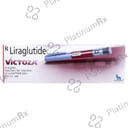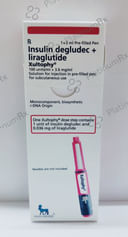Liraglutide
Uses
Liraglutide is used in the treatment of type 2 diabetes mellitus. It is administered in conjunction with diet and exercise to enhance blood sugar control in adults with this condition.
How it Works
How Liraglutide works Liraglutide is an anti-diabetic medication. It works by increasing the release of insulin from the pancreas, decreasing hormones that raise blood sugar levels, slowing down digestion, and reducing appetite.
Side Effects
Common side effects of Liraglutide include constipation, decreased appetite, diarrhea, nausea, vomiting, abdominal pain, dyspepsia, flatulence, and nasopharyngitis (inflammation of the throat and nasal passages).
Expert Advice
- Liraglutide helps to control blood glucose levels and prevents long-term complications of diabetes.
- Liraglutide should be injected under the skin of your abdomen or thigh at the same time every day.
- Do not administer intravenously or intramuscularly.
- Store the pen in the refrigerator.
- When refrigeration is not possible, you can keep your pen at room temperature (less than 30°C) for up to 2 weeks.
- Do not freeze the pen.
- Liraglutide may cause nausea. To minimize this effect:
- Eat smaller meals.
- Limit fatty food intake.
- Stop eating when you feel full.
- Notify your doctor immediately if you experience severe and/or persistent upper abdominal pain and vomiting.
- You should continue to exercise regularly, eat a healthy diet, and take your other diabetes medications (if prescribed) along with Liraglutide.
- Inject under the skin of your belly, thighs, or the back of your upper arm.
- If you miss a dose, take it as soon as you remember. If the next dose is within the next 72 hours, skip the missed dose.
- Notify your doctor immediately if you have severe and/or persistent upper abdominal pain.
- Do not use Liraglutide if you notice that the pen is damaged, or if the medicine does not appear clear and colorless.
Other Combinations
Liraglutide + Insulin Degludec
Related Medications
Liraglutide 6mg

₹2,000

₹1,725
MRP ₹1,875
Liraglutide 6mg

₹5,324

₹1,725
MRP ₹1,875
Liraglutide 6mg

₹1,875

₹1,725
MRP ₹1,875
Liraglutide 6mg

₹1,725
MRP ₹1,875
Liraglutide 6mg

₹1,562.1
MRP ₹1,905
Insulin Degludec 100mg + 100 IU | Liraglutide 3.6mg

₹26,884.7

₹4,409.1
MRP ₹5,376.9
Insulin Degludec 100mg + 100 IU | Liraglutide 3.6mg

₹4,409.1
MRP ₹5,376.9